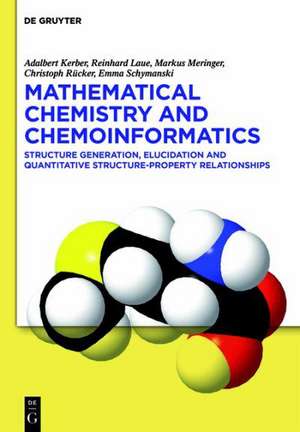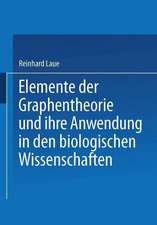Mathematical Chemistry and Chemoinformatics: Structure Generation, Elucidation and Quantitative Structure-Property Relationships
Autor Adalbert Kerber, Reinhard Laue, Markus Meringer, Christoph Rücker, Emma Schymanskien Limba Engleză Hardback – 31 dec 2013
- More than 20 years of experience in molecular structure generation, from conceptualization through to applications
- Innovative, interdisciplinary text demonstrating example queries with software packages such as MOLGEN-online
- Detailed explanations on establishing QSPRs and QSARs as well as structure elucidation using mass spectrometry and structure generation.
Aims and Scope
This work provides an introduction to mathematical modeling of molecules and the resulting applications (structure generation, structure elucidation, QSAR/QSPR etc.). Most chemists have experimented with some software that represents molecules in an electronic form, and such models and applications are of increasing interest in diverse and growing fields such as drug discovery, environmental science and metabolomics. Furthermore, structure generation remains the only way to systematically create molecules that are not (yet) present in a database. This book starts with the mathematical theory behind representing molecules, explaining chemical concepts in mathematical terms and providing exercises that can be completed online. The later chapters cover applications of the theory, with detailed explanations on QSPR and QSAR investigations and finally structure elucidation combining mass spectrometry and structure generation. This book is aimed in particular at the users of structure generation methods and corresponding techniques, but also for those interested in teaching and learning mathematical chemistry, and for software designers in chemoinformatics.
Preț: 937.79 lei
Preț vechi: 1030.53 lei
-9% Nou
179.45€ • 191.89$ • 149.62£
Carte tipărită la comandă
Livrare economică 14-19 aprilie
Specificații
ISBN-10: 3110300079
Pagini: 520
Ilustrații: 124 schw.-w. Abb., 70 schw.-w. Tab.
Dimensiuni: 170 x 240 x 33 mm
Greutate: 1 kg
Editura: De Gruyter
Colecția De Gruyter
Locul publicării:Berlin/Boston
Notă biografică
Cuprins
Chapter 1: Molecules in silico 1.1 Graphs, labeled and unlabeled 1.2 Molecular graphs, constitutional isomers 1.3 Summary Chapter 2: Substructures, reactions, descriptors 2.1 Substructures 2.2 Molecular substructures 2.3 Chemical reactions 2.4 Mesomerism 2.5 Existing chemical compounds 2.6 Molecular descriptors 2.7 Summary Chapter 3: Chirality 3.1 Orientation and chirality 3.2 Permutational isomers 3.3 Permutational isomers by content, in particular by racemic content 3.4 Enumeration by symmetry 3.5 Constructive aspects 3.6 Summary Chapter 4: Stereoisomers 4.1 Stereoisomers 4.2 Radon partitions 4.3 Binary Grassmann-Plücker relations 4.4 An example, cyclohexane 4.5 Summary Chapter 5: Molecular structure generation 5.1 Formula based molecular generation 5.2 Reaction based structure generation 5.3 Examples: Combinatorial libraries 5.4 Generic structural formulas 5.5 Example: Patents in chemistry 5.6 Canonizing molecules and graphs 5.7 Data structure for molecular graphs 5.8 Summary Chapter 6: Supervised statistical learning 6.1 Variables and predicting functions 6.2 Models for predicting functions 6.3 Summary Chapter 7: Structure-property relationships 7.1 Optimization of experiments in combinatorial chemistry 7.2 The use of molecular descriptors 7.3 Quantitative structure--property relationships 7.4 Example: Boiling points of alkanes 7.5 Example: Physical density of propyl acrylates 7.6 Example: Antibacterial activity of quinolones 7.7 Remarks on the real library 7.8 Summary Chapter 8: Molecular structure elucidation 8.1 Spectroscopic methods 8.2 The principle of automated molecular structure elucidation 8.3 Basics of mass spectrometry 8.4 Ranking functions for mass spectra 8.5 Classification of mass spectra 8.6 Automated structure elucidation via MS 8.7 High resolution MS 8.8 Molecular formulas from high-resolution MS and MS/MS 8.9 Summary Chapter 9: Case studies of CASE 9.1 Automated structure elucidation with MOLGEN-MS 9.2 Calculated properties to improve CASE 9.3 Examples of CASE at work Chapter 10: Appendix 10.1 Lists of molecular descriptors 10.2 Substructures for MS classifiers 10.3 Molecular formulas, according to mass and ion type 10.4 Isomers, by formula and mass 10.5 Summary

















